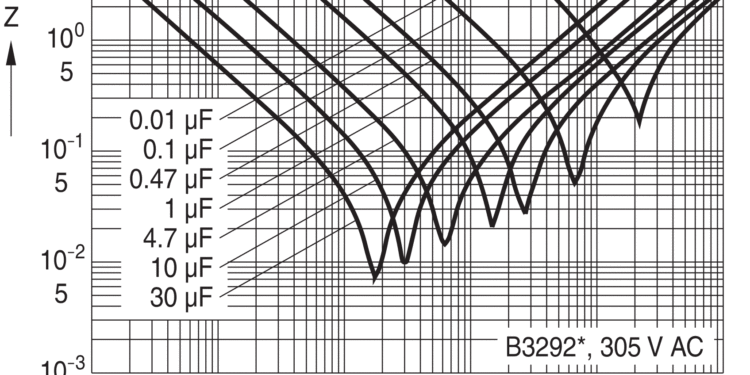source: EDN article
Michael Dunn -April 03, 2017. Most of us with a decent knowledge of components know that ceramic capacitors can sing, or, act as mechanical-to-voltage converters. But metalized film?
In Why is everything junk? (Heat-pump edition), I reviewed and analyzed the electrical and functional behaviour of my heat-pump system and the problems it caused the induction cooktop. I postulated that throwing some capacitance across the 240V AC line might solve my problem by absorbing the interfering audio-band line noise generated by the heat pump. Well, I finally tried it, and the results are a definite maybe.

Figure 1 The 15µF X2 (AC-line rated) capacitor assembly
For my first try, I connected the cap assembly to a spare pair of circuit-breaker outputs. Upon flipping the breaker, I immediately noticed a surprisingly high acoustic noise level emitted from the capacitor! This was…worrisome, to say the least. Still, it didn’t burst into flames, explode, or even get warm.
But did it have the desired effect of quieting the induction cooktop? Just barely.
So…it was doing something, but, not much of it. I next paralleled the cap across the cooktop breaker’s output (though having both wires connected to one breaker would not be acceptable for a permanent installation). This time, the quieting effect on the cooktop was more noticeable, but still nothing to write home about.
For reference, here are some capacitor graphs:

Figure 2 Capacitor impedance vs. frequency: Interpolating between the 10µF & 30µF lines, the impedance varies from 0.5Ω to 10Ω over the 1kHz to 20kHz band – we’re far enough from the 250kHz self-resonance that the cap’s impedance is close to ideal (p/n: B32926D3156K; source: TDK/Epcos).

Figure 3 Permissible AC current through the cap: Extrapolating down to 60Hz returns about 1.5A. XC @60Hz is 177Ω. At 240 VAC, that’s 1.4A, which doesn’t leave much “headroom” for all the higher-frequency noise current. Presumably the graph only applies to a single frequency component, and one must somehow “integrate” current across the band (source: TDK/Epcos).
A call to Epcos might be in order to help interpret Figure 3. And I’ll need to measure voltage across or current through the cap (with a scope/FFT) to get a clear understanding of what’s going on.
But getting back to the scary capacitor singing, I did some research, and sure enough, the manufacturer’s application note mentions:
6.4 Buzz noise
Under AC regime, buzzing noise is produced in film capacitors by the mechanical vibration of the films, due to the Coulomb force existing between electrodes of opposite polarity. Buzz noise becomes louder if the applied voltage waveform presents distortion and/or high frequency harmonics. Buzz noise does not affect the capacitor structure, nor its electrical characteristics or reliability.
Given the cap slightly but noticeably quieted the cooktop, I imagine that using several in parallel might make a significant improvement. Additionally, I could house the caps in an electrical box in the basement, inserted near the load-end of the line, which would provide about 5m of wiring impedance to my filtering advantage.
I must confirm the caps won’t incur a “running cost”. A purely capacitive load should theoretically not make the electric meter spin, but as we all know, theory and practice have been known to diverge.































